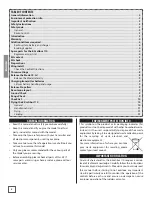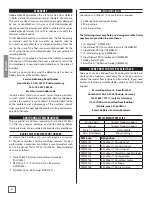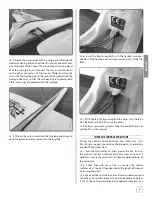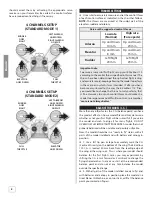
10
CHECKLIST
Just prior to taking off, your mind may be elsewhere,
anticipating the excitement of your first flight with the
E-Xcalibur 110. This could cause you to overlook certain
checks and procedures that should always be performed
before the model is flown. To help avoid this, we’ve put
together a basic checklist to make sure that important
pre-flight checks are not overlooked. Additionally, many
are covered in more detail in other parts of this instruction
manual. Be sure to check them off as each check is
completed.
❍
1. Always check that all motors are securely attached.
❍
2. Check the C.G. according to the measurements
provided in this manual.
❍
3. Check your transmitter’s antenna.
❍
4. Balance the model laterally as detailed in this manual.
❍
5. Tighten the propeller nut.
❍
6. With motors disarmed, turn the propeller one full
revolution to ensure it is moving freely.
❍
7. Add a drop of oil to each wheel axle to ensure wheels
turn freely.
❍
8. Make sure all hinges are securely glued in place.
❍
9. Check that each rudder arm is secured.
❍
10. Check that every linkage is secured.
❍
11. Ensure all servo arms are secured to their servos with
their respective screws.
❍
12. Make sure servo wires do not interfere with any
moving parts and double-check all connections are
secure.
❍
13. Balance all propellers.
❍
14. Make sure the canopy and cowls are secured.
❍
15. Include your name, address and telephone number
somewhere inside the model.
❍
16. Range check your radio when you get to the flying
site.
❍
17. Confirm that all control functions operate in the
correct direction and that throws are set up according to
this manual.
❍
18. Use threadlocking compound to secure all critical
metal to metal fasteners, such as the set screws that hold
the wheel axles to the wheel struts, etc.
❍
19. Reinforce holes for wood screws with small amounts
of CA glue, as this helps prevent cracking, etc.
❍
20. Check for foreign bodies that may have entered the
motor housing.
❍
21. If you wish to photograph your model, do so before
your first flight.
FLYING THE E-XCALIBUR 110
GENERAL
The E-Xcalibur 110 is a great-flying model that flies smoothly
and predictably. However, it is not a model for beginners, it
have a wide speed range and a lot of power, and is intended
for pilots with an intermediate RC experience. If the E-Xcalibur
110 is your 1st RC model, or if your experience is low, you need
to be assisted by an experienced modeller, able to take control
if needed. An experienced pilot may avoid a critical situation
and you will enjoy more quicky your E-Xcalibur 110.
For the first flights, ask to an assistant to launch the model, so
you can keep your hands on the radio, to to be ready to correct
path deviations. Later, with the model perfectly set (trimmed),
you will be able to launch the E-Xcalibur by yourself.
Always remember to comply with the local laws and regulations
regarding the operation of radio controlled models. Read also
all the safety instrucions at the beginning of this manual.
CAUTION
(Applies to all RC aircraft): If, whilst flying, you
notice an alarming or unusual sound like a low-pitched
“buzz”, this may indicate control surface flutter. Flutter
occurs when a control surface (such as aileron or elevator)
or a flying surface (such as wing or stabilizer) rapidly vibrates
up and down (thus causing the noise). In extreme cases, if
not detected early enough, flutter can actually cause the
flying surface to fail and detach, thus causing a loss of
control and potential crash. The best thing to do if flutter is
detected is to land as soon as safely possible. Identify which
surface fluttered so that the problem can be resolved. Check
all servo grommets for signs of deterioration or vibration.
Make sure all pushrod linkages are free of excess play. If a
surface fluttered once, under similar circumstances, it will
probably flutter again unless the problem is fixed. Things
that can cause flutter include; Excessive hinge gap, Not
mounting control horns solidly, Side-play of wire pushrods
(caused by large bends), Excessive free-play in servo gears
(wear) and Unsecured servo mountings. The most common
cause of flutter is flying an overpowered model at excessive
speed!
ENGLISH
Summary of Contents for TZNA1100
Page 12: ...Distributed by www hobbico de...






























